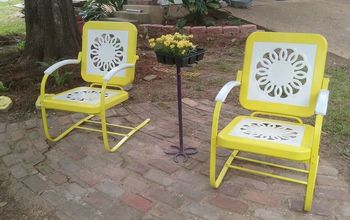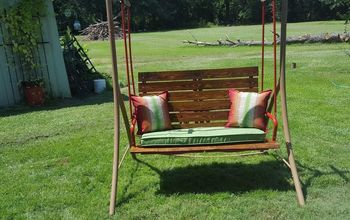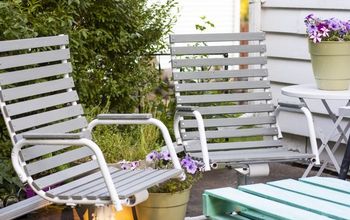3 Views
Maintaining Our Indoor/Outdoor Furniture in Every Season

by
Brooke Bowman
(IC: blogger)
4 Materials
$250
2 Hours
Easy
While our cottage does not have a front porch, it does have a very sweet and old-fashioned side porch. While this is now my and my daughter’s favorite spot to sit and read in the afternoons while we watch the school buses pass by our house, there was a time when the space was empty and in dire need of a little TLC. When we made the decision to buy our home, we did so knowing that its curb appeal depended on what we did with the side porch. When we bought it, there was indoor/outdoor carpet installed underfoot, old rusty chains hanging where overhead baskets used to sway and an old red bench that stood looking out at the road.
Before we removed the carpet (a step that came a few months later and that we are still working on), we decided to invest in a poly lumber outdoor bench for the side porch. We did not know how to properly care for it then but we have learned a few valuable tricks along the way. Here are a few of our go-to tricks and tips for ensuring that your pieces are protected and allowed to shine in every season.
We purchased our bench from a local Amish trading post, which procures these unique and original pieces directly from the Amish communities in Pennsylvania. While many outdoor swings and gliders are constructed from wood that is then painted various shades to match exterior aesthetics, poly lumber is designed to mimic the appearance of wood but without the splinters and difficult upkeep. In other words, it will not weather, even at 100 years old. What it will do, however, is attract grime that can sink into its tiny pockmarks, giving it the appearance of being dirty even when it truly is not.
We spoke to the shop owners about this issue, and they recommended cleaning the swing with a mild degreaser (we have found that Grease Lightning works well), giving it a good scrub-down once a month, and spraying it off gently with a garden hose. It is important not to scrub too vigorously, as this can break down the material over time, but you should apply enough elbow grease to lift up the particles so they are easier to wash off.
While our poly lumber bench is the main focal point of our side porch and the one that we spend the most time on, we do have another blue bench that is along the right hand brick wall. This bench features two bright blue vinyl upholstered cushions and a faux wood middle panel, where we place a potted plant. Unlike the poly lumber bench, this one does not show grime as much on the wood, but still requires routine cleaning, as the tiny hairline cracks in the vinyl cushion can hold grime over time. For these, I simply dampen a wet washcloth in warm water and a little dishwashing liquid, and most of the dirt comes right up.
It is worth noting that positioning our poly lumber bench where we did, it is right in front of a large tree that sits adjacent to the left side of our house. During one storm, a branch snapped off the tree and into the back of the bench. Though the material is designed to be virtually indestructible, it did leave a little scratch. Instead of trying to fix it or pop it back out as one would during a vehicular dent removal process, we just decided to leave it. If your outdoor furniture is exposed to the elements and takes a similar hit, I would suggest analyzing the extent of the damages first.
If they are in an area that is not too obvious, it is often in your best interest to leave them, as attempting a homemade remedy could exacerbate the condition. Then, be sure to move the furniture to an area that is a little safer and more out of the way.
In the fall and winter, where our area of North Carolina tends to get a heavy amount of rainfall and strong winds, we try to store the poly lumber bench on its back when not in use so it is not knocked over onto the shrub garden beneath it. While it is not feasible to do so with the blue bench, we do place an oversized picnic blanket over it to protect it from the elements.
In the depth of winter when snow begins to fall, we prefer to drape our outdoor furniture with heavy blankets and bring the cushions inside to keep them dry. While they are intended for indoor or outdoor use and can technically get wet, the stuffing inside of them can wear down and even harbor harmful mildew and bacteria over time if not allowed to properly and thoroughly air dry, so we just opt to bring them in away from the rain, sleet or snow in the first place.
If they do get caught in an unexpected downpour, I have found that popping the smaller cushions in the dryer as soon as I can get to them works fine as a temporary fix.
We also drape blankets over our cushions during the day in the heat of the summer, as the sun’s strong rays can fade the material so quickly. We found this out the hard way when we left for a two-week long family beach trip this summer and came back to find that our bright and bold glider cushion had faded to a barely recognizable pastel version because we had failed to drape anything over it and it sits in the direct path of the strong afternoon sun.
Other than that, we treat our outdoor furniture with the same care and attention that we do our indoor pieces. By taking steps to routinely clean them, protect them from the weather and keep them looking great and sitting well, we have been able to keep some of the same furniture for close to 10 years. As we prepare for yet another move in the upcoming spring of 2019, we will bring the glider and the blue bench with us, careful to preserve them for the next decade or so!
Enjoyed the project?
Suggested materials:
- Poly Lumber Outdoor Bench (Hardware Store)
- Degreasing Spray (Home Goods Store)
- Scrubbing Brush (Home Goods Store)
- Water Hose (Hardware Store)

Want more details about this and other DIY projects? Check out my blog post!
Published May 10th, 2024 6:54 PM






























Frequently asked questions
Have a question about this project?